Effective Business Communication Analysis: ABC Corporation Report
VerifiedAdded on 2020/05/16
|22
|2688
|68
Report
AI Summary
This report provides an in-depth analysis of organizational communication within ABC Corporation, examining various aspects such as messages, symbols, interactions, media, relationships, persuasive campaigns, networks, and broader discourses. The study utilizes a case study approach, focusing on ABC Corporation's internal communication, including public relations, investor relations, labor market communication, environmental communication, corporate advertising, and communication between workers and department managers. The report employs both qualitative and quantitative research methods, including surveys and focus groups, to gather data on employee and management perspectives. Key findings highlight the importance of communication between employees and managers, the adoption of leadership theories, and the role of communication in problem-solving and organizational success. The report concludes with recommendations for ABC Corporation to enhance its communication strategies, including promoting cultural competency and fostering a diverse and inclusive workplace. The research emphasizes the significance of effective communication in achieving organizational goals and maintaining a positive work environment.
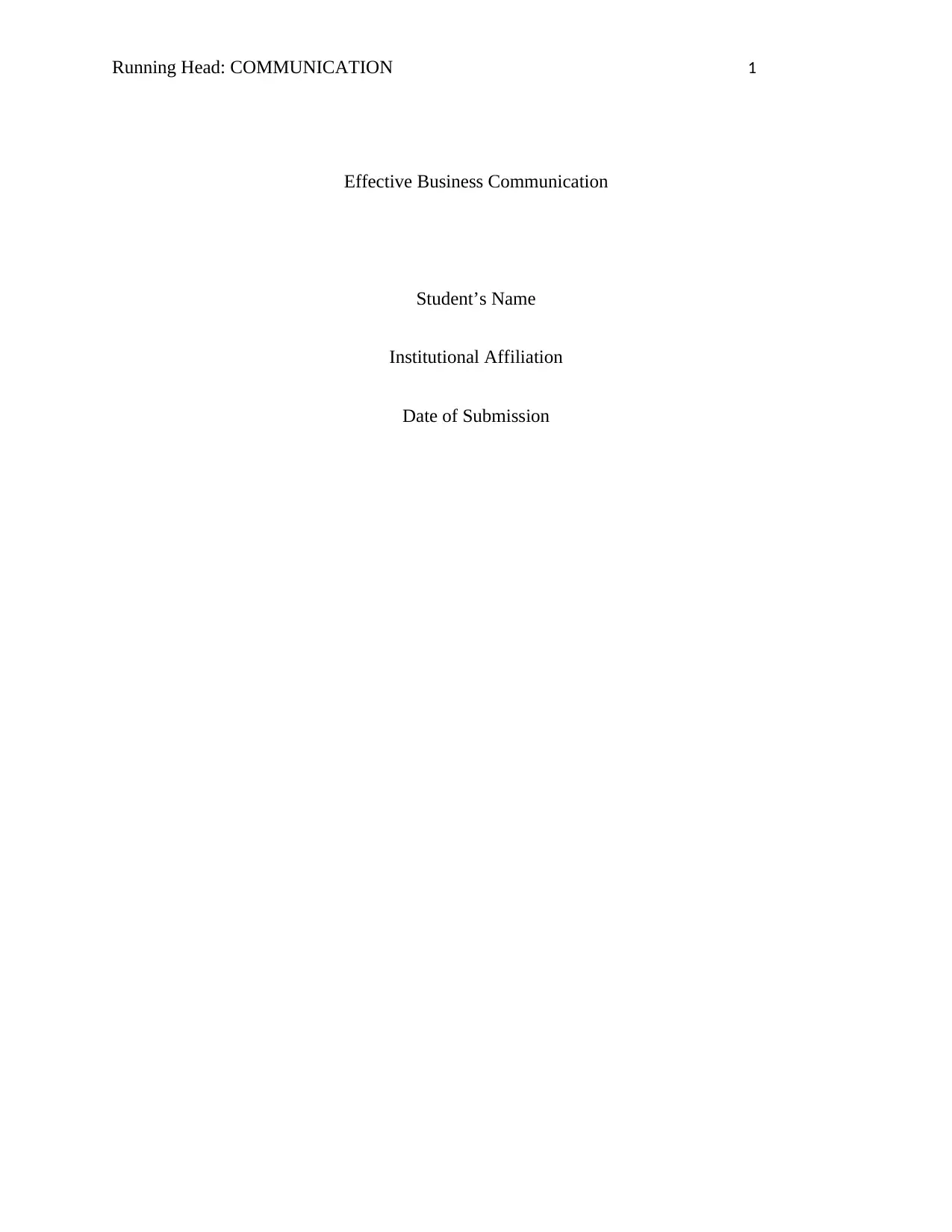
Running Head: COMMUNICATION 1
Effective Business Communication
Student’s Name
Institutional Affiliation
Date of Submission
Effective Business Communication
Student’s Name
Institutional Affiliation
Date of Submission
Paraphrase This Document
Need a fresh take? Get an instant paraphrase of this document with our AI Paraphraser
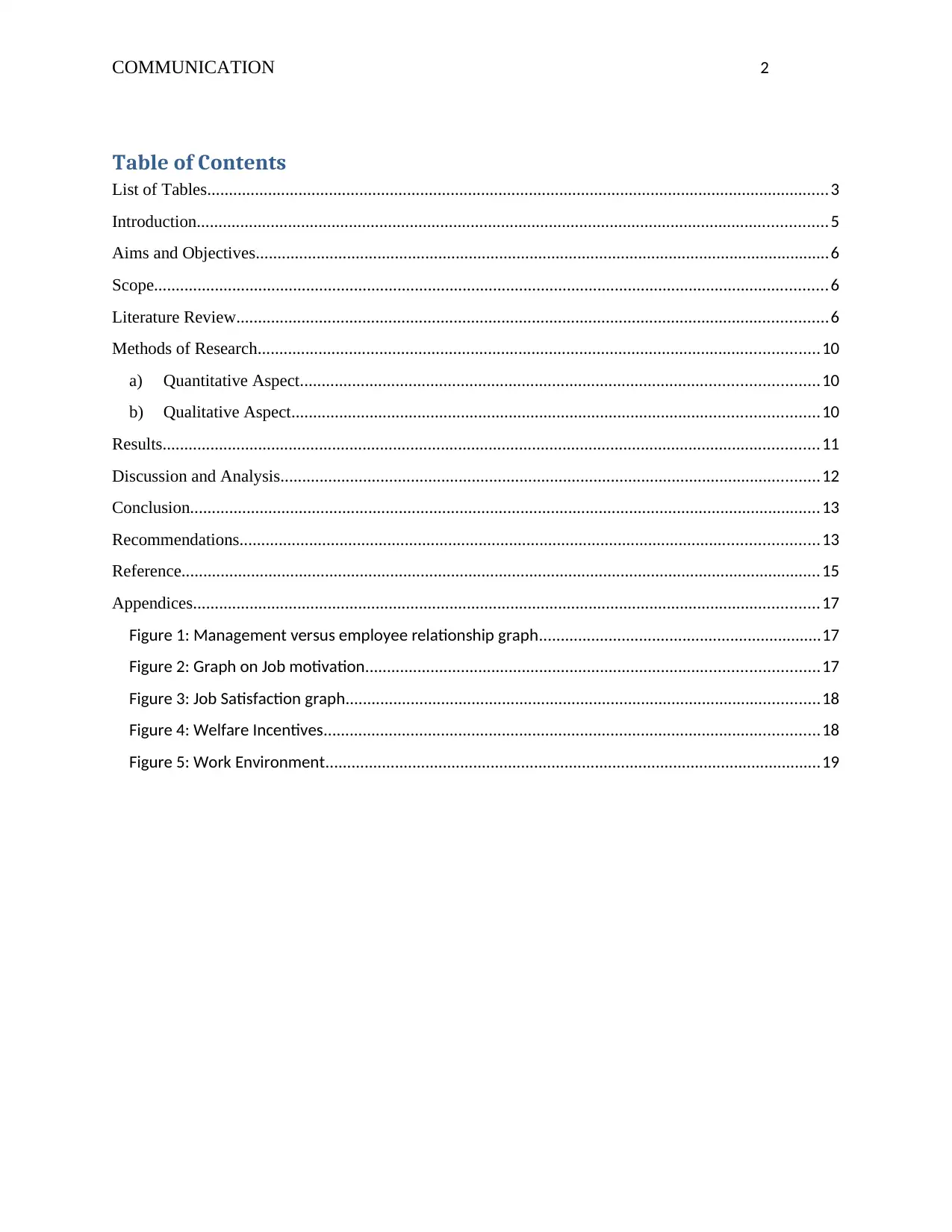
COMMUNICATION 2
Table of Contents
List of Tables...............................................................................................................................................3
Introduction.................................................................................................................................................5
Aims and Objectives....................................................................................................................................6
Scope...........................................................................................................................................................6
Literature Review........................................................................................................................................6
Methods of Research.................................................................................................................................10
a) Quantitative Aspect.......................................................................................................................10
b) Qualitative Aspect.........................................................................................................................10
Results.......................................................................................................................................................11
Discussion and Analysis............................................................................................................................12
Conclusion.................................................................................................................................................13
Recommendations.....................................................................................................................................13
Reference...................................................................................................................................................15
Appendices................................................................................................................................................17
Figure 1: Management versus employee relationship graph.................................................................17
Figure 2: Graph on Job motivation........................................................................................................17
Figure 3: Job Satisfaction graph.............................................................................................................18
Figure 4: Welfare Incentives..................................................................................................................18
Figure 5: Work Environment..................................................................................................................19
Table of Contents
List of Tables...............................................................................................................................................3
Introduction.................................................................................................................................................5
Aims and Objectives....................................................................................................................................6
Scope...........................................................................................................................................................6
Literature Review........................................................................................................................................6
Methods of Research.................................................................................................................................10
a) Quantitative Aspect.......................................................................................................................10
b) Qualitative Aspect.........................................................................................................................10
Results.......................................................................................................................................................11
Discussion and Analysis............................................................................................................................12
Conclusion.................................................................................................................................................13
Recommendations.....................................................................................................................................13
Reference...................................................................................................................................................15
Appendices................................................................................................................................................17
Figure 1: Management versus employee relationship graph.................................................................17
Figure 2: Graph on Job motivation........................................................................................................17
Figure 3: Job Satisfaction graph.............................................................................................................18
Figure 4: Welfare Incentives..................................................................................................................18
Figure 5: Work Environment..................................................................................................................19
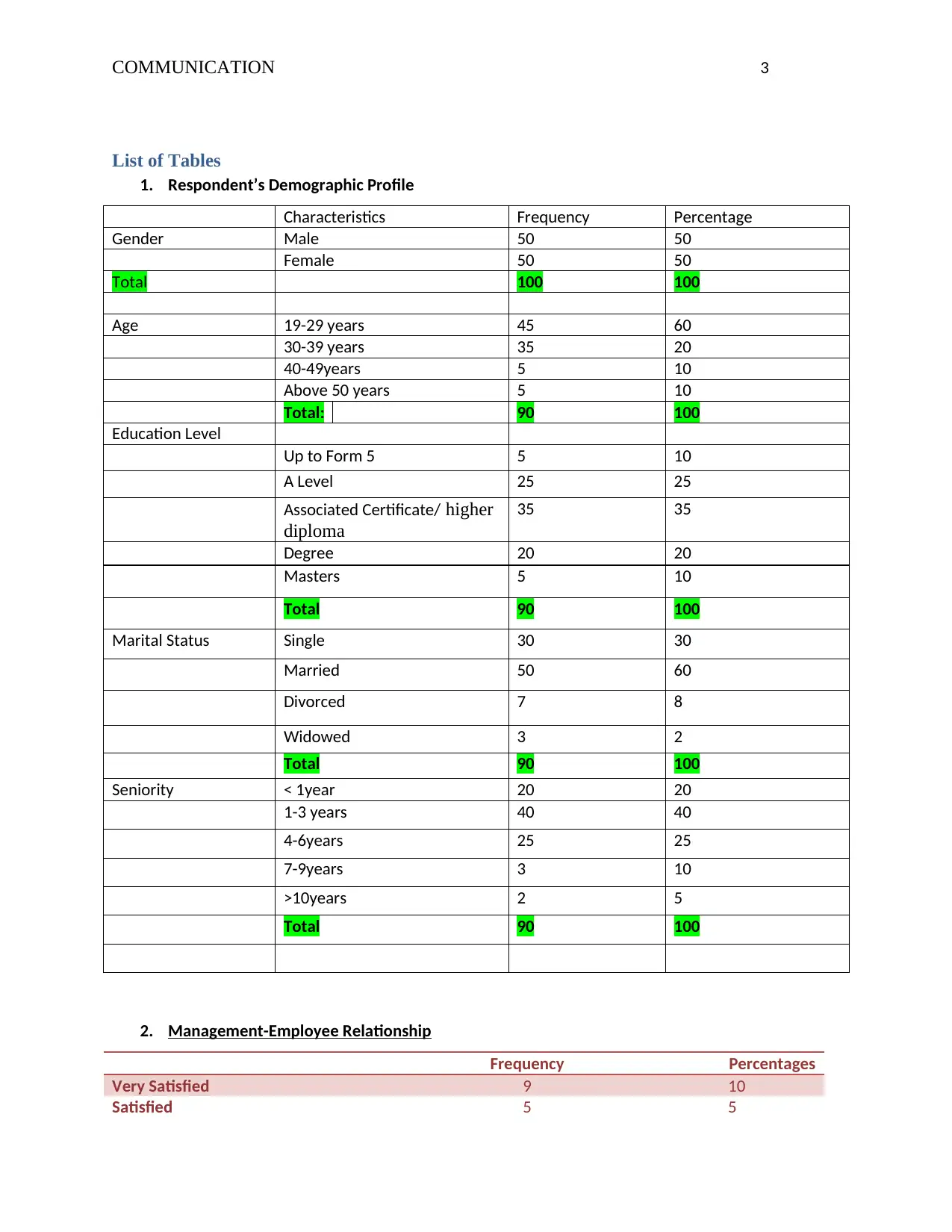
COMMUNICATION 3
List of Tables
1. Respondent’s Demographic Profile
Characteristics Frequency Percentage
Gender Male 50 50
Female 50 50
Total 100 100
Age 19-29 years 45 60
30-39 years 35 20
40-49years 5 10
Above 50 years 5 10
Total: 90 100
Education Level
Up to Form 5 5 10
A Level 25 25
Associated Certificate/ higher
diploma
35 35
Degree 20 20
Masters 5 10
Total 90 100
Marital Status Single 30 30
Married 50 60
Divorced 7 8
Widowed 3 2
Total 90 100
Seniority < 1year 20 20
1-3 years 40 40
4-6years 25 25
7-9years 3 10
>10years 2 5
Total 90 100
2. Management-Employee Relationship
Frequency Percentages
Very Satisfied 9 10
Satisfied 5 5
List of Tables
1. Respondent’s Demographic Profile
Characteristics Frequency Percentage
Gender Male 50 50
Female 50 50
Total 100 100
Age 19-29 years 45 60
30-39 years 35 20
40-49years 5 10
Above 50 years 5 10
Total: 90 100
Education Level
Up to Form 5 5 10
A Level 25 25
Associated Certificate/ higher
diploma
35 35
Degree 20 20
Masters 5 10
Total 90 100
Marital Status Single 30 30
Married 50 60
Divorced 7 8
Widowed 3 2
Total 90 100
Seniority < 1year 20 20
1-3 years 40 40
4-6years 25 25
7-9years 3 10
>10years 2 5
Total 90 100
2. Management-Employee Relationship
Frequency Percentages
Very Satisfied 9 10
Satisfied 5 5
⊘ This is a preview!⊘
Do you want full access?
Subscribe today to unlock all pages.

Trusted by 1+ million students worldwide
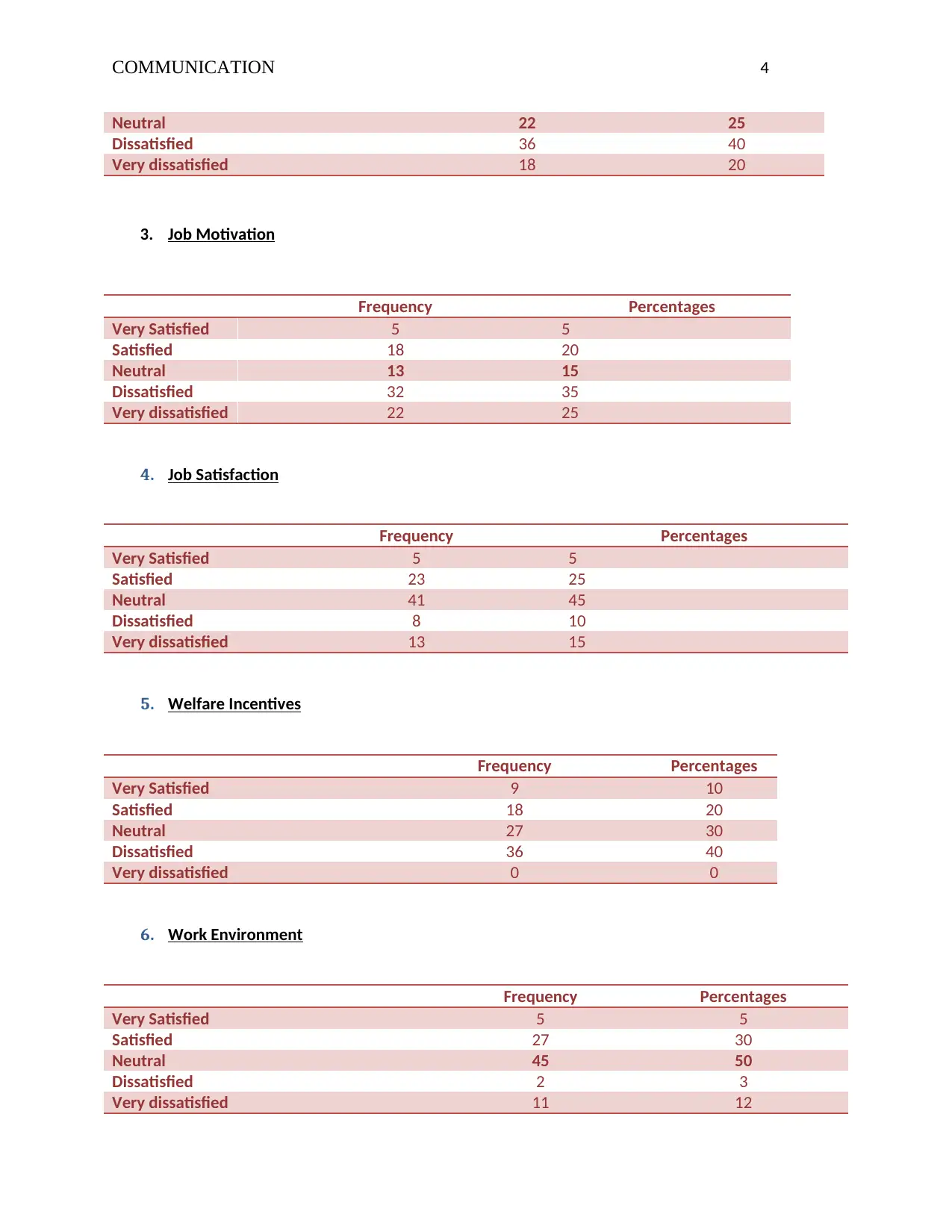
COMMUNICATION 4
Neutral 22 25
Dissatisfied 36 40
Very dissatisfied 18 20
3. Job Motivation
Frequency Percentages
Very Satisfied 5 5
Satisfied 18 20
Neutral 13 15
Dissatisfied 32 35
Very dissatisfied 22 25
4. Job Satisfaction
Frequency Percentages
Very Satisfied 5 5
Satisfied 23 25
Neutral 41 45
Dissatisfied 8 10
Very dissatisfied 13 15
5. Welfare Incentives
Frequency Percentages
Very Satisfied 9 10
Satisfied 18 20
Neutral 27 30
Dissatisfied 36 40
Very dissatisfied 0 0
6. Work Environment
Frequency Percentages
Very Satisfied 5 5
Satisfied 27 30
Neutral 45 50
Dissatisfied 2 3
Very dissatisfied 11 12
Neutral 22 25
Dissatisfied 36 40
Very dissatisfied 18 20
3. Job Motivation
Frequency Percentages
Very Satisfied 5 5
Satisfied 18 20
Neutral 13 15
Dissatisfied 32 35
Very dissatisfied 22 25
4. Job Satisfaction
Frequency Percentages
Very Satisfied 5 5
Satisfied 23 25
Neutral 41 45
Dissatisfied 8 10
Very dissatisfied 13 15
5. Welfare Incentives
Frequency Percentages
Very Satisfied 9 10
Satisfied 18 20
Neutral 27 30
Dissatisfied 36 40
Very dissatisfied 0 0
6. Work Environment
Frequency Percentages
Very Satisfied 5 5
Satisfied 27 30
Neutral 45 50
Dissatisfied 2 3
Very dissatisfied 11 12
Paraphrase This Document
Need a fresh take? Get an instant paraphrase of this document with our AI Paraphraser
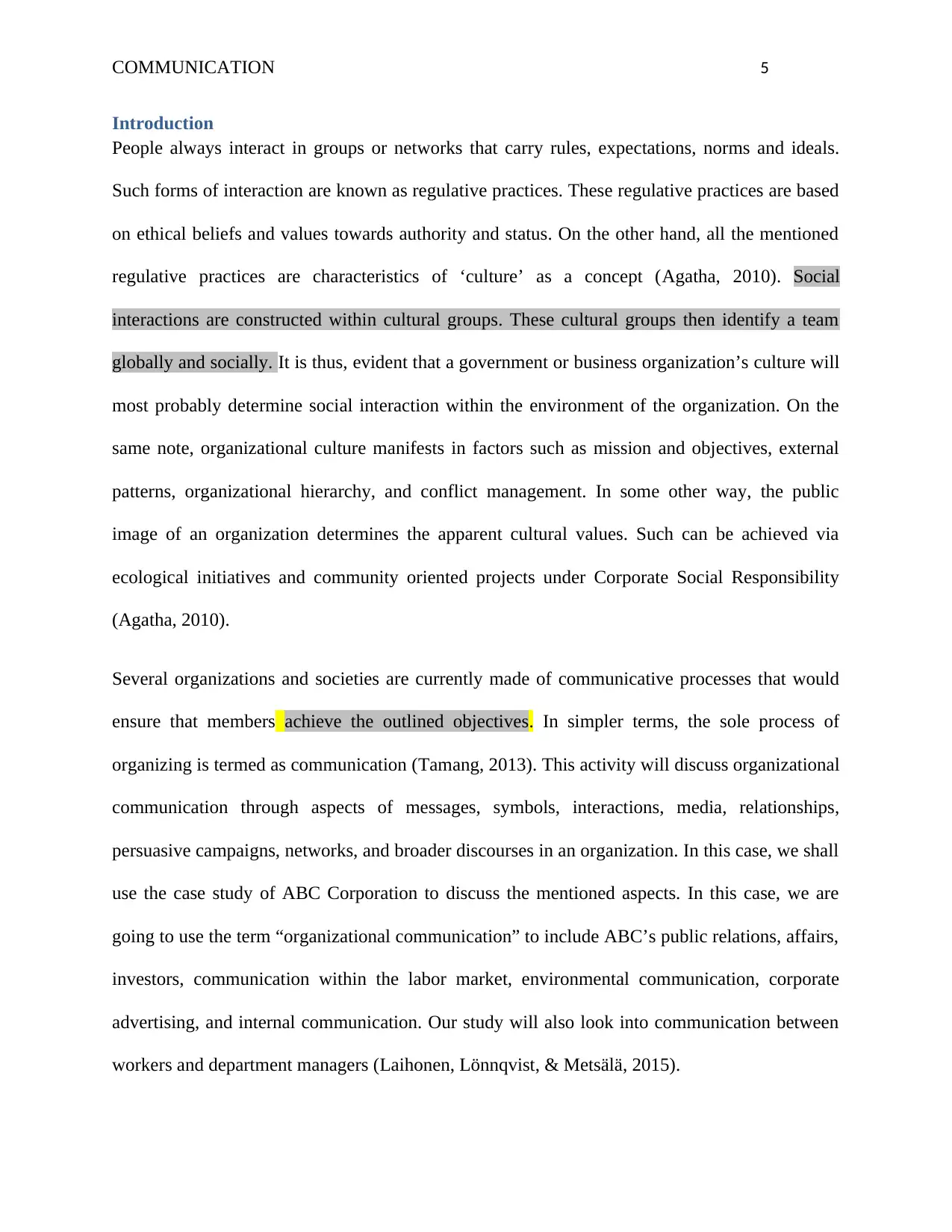
COMMUNICATION 5
Introduction
People always interact in groups or networks that carry rules, expectations, norms and ideals.
Such forms of interaction are known as regulative practices. These regulative practices are based
on ethical beliefs and values towards authority and status. On the other hand, all the mentioned
regulative practices are characteristics of ‘culture’ as a concept (Agatha, 2010). Social
interactions are constructed within cultural groups. These cultural groups then identify a team
globally and socially. It is thus, evident that a government or business organization’s culture will
most probably determine social interaction within the environment of the organization. On the
same note, organizational culture manifests in factors such as mission and objectives, external
patterns, organizational hierarchy, and conflict management. In some other way, the public
image of an organization determines the apparent cultural values. Such can be achieved via
ecological initiatives and community oriented projects under Corporate Social Responsibility
(Agatha, 2010).
Several organizations and societies are currently made of communicative processes that would
ensure that members achieve the outlined objectives. In simpler terms, the sole process of
organizing is termed as communication (Tamang, 2013). This activity will discuss organizational
communication through aspects of messages, symbols, interactions, media, relationships,
persuasive campaigns, networks, and broader discourses in an organization. In this case, we shall
use the case study of ABC Corporation to discuss the mentioned aspects. In this case, we are
going to use the term “organizational communication” to include ABC’s public relations, affairs,
investors, communication within the labor market, environmental communication, corporate
advertising, and internal communication. Our study will also look into communication between
workers and department managers (Laihonen, Lönnqvist, & Metsälä, 2015).
Introduction
People always interact in groups or networks that carry rules, expectations, norms and ideals.
Such forms of interaction are known as regulative practices. These regulative practices are based
on ethical beliefs and values towards authority and status. On the other hand, all the mentioned
regulative practices are characteristics of ‘culture’ as a concept (Agatha, 2010). Social
interactions are constructed within cultural groups. These cultural groups then identify a team
globally and socially. It is thus, evident that a government or business organization’s culture will
most probably determine social interaction within the environment of the organization. On the
same note, organizational culture manifests in factors such as mission and objectives, external
patterns, organizational hierarchy, and conflict management. In some other way, the public
image of an organization determines the apparent cultural values. Such can be achieved via
ecological initiatives and community oriented projects under Corporate Social Responsibility
(Agatha, 2010).
Several organizations and societies are currently made of communicative processes that would
ensure that members achieve the outlined objectives. In simpler terms, the sole process of
organizing is termed as communication (Tamang, 2013). This activity will discuss organizational
communication through aspects of messages, symbols, interactions, media, relationships,
persuasive campaigns, networks, and broader discourses in an organization. In this case, we shall
use the case study of ABC Corporation to discuss the mentioned aspects. In this case, we are
going to use the term “organizational communication” to include ABC’s public relations, affairs,
investors, communication within the labor market, environmental communication, corporate
advertising, and internal communication. Our study will also look into communication between
workers and department managers (Laihonen, Lönnqvist, & Metsälä, 2015).
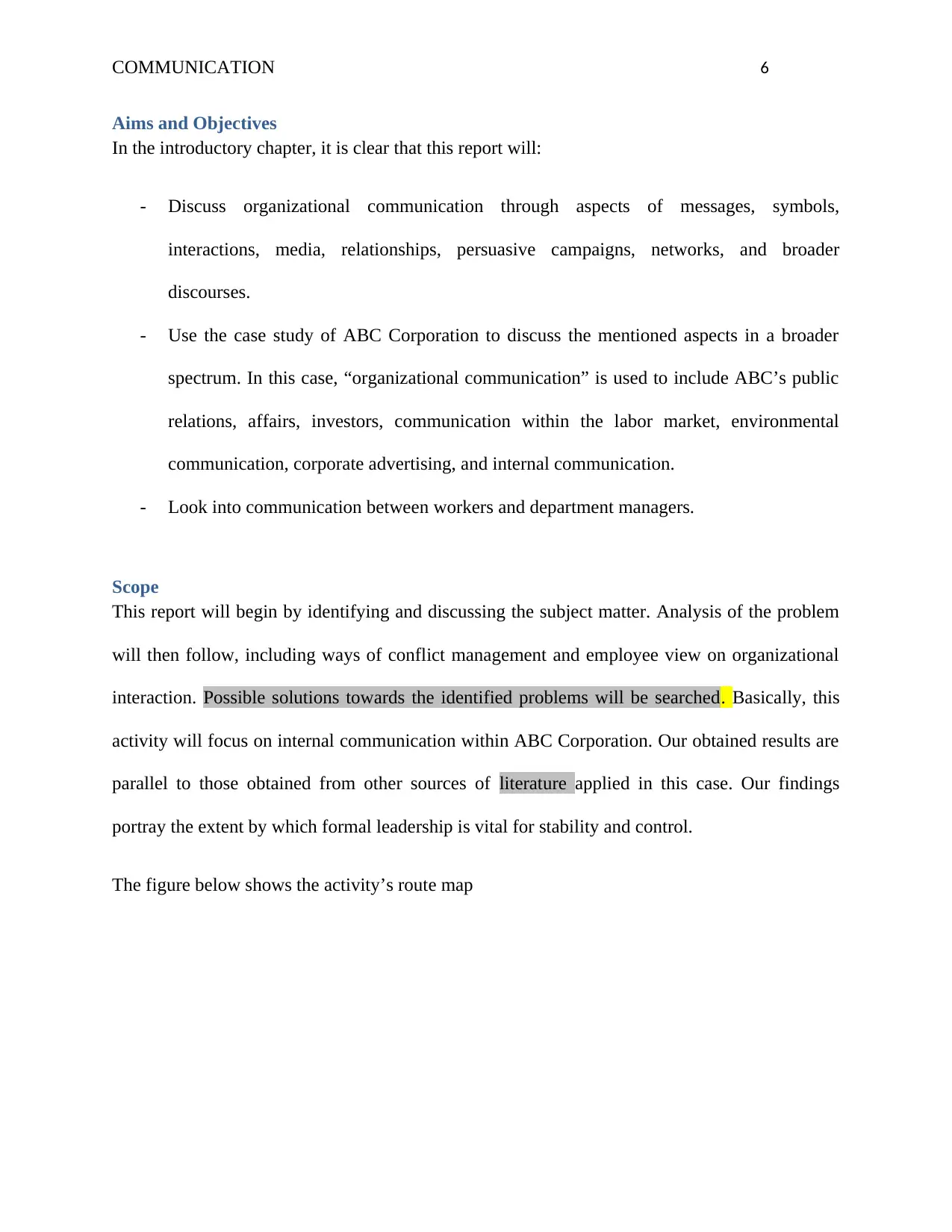
COMMUNICATION 6
Aims and Objectives
In the introductory chapter, it is clear that this report will:
- Discuss organizational communication through aspects of messages, symbols,
interactions, media, relationships, persuasive campaigns, networks, and broader
discourses.
- Use the case study of ABC Corporation to discuss the mentioned aspects in a broader
spectrum. In this case, “organizational communication” is used to include ABC’s public
relations, affairs, investors, communication within the labor market, environmental
communication, corporate advertising, and internal communication.
- Look into communication between workers and department managers.
Scope
This report will begin by identifying and discussing the subject matter. Analysis of the problem
will then follow, including ways of conflict management and employee view on organizational
interaction. Possible solutions towards the identified problems will be searched. Basically, this
activity will focus on internal communication within ABC Corporation. Our obtained results are
parallel to those obtained from other sources of literature applied in this case. Our findings
portray the extent by which formal leadership is vital for stability and control.
The figure below shows the activity’s route map
Aims and Objectives
In the introductory chapter, it is clear that this report will:
- Discuss organizational communication through aspects of messages, symbols,
interactions, media, relationships, persuasive campaigns, networks, and broader
discourses.
- Use the case study of ABC Corporation to discuss the mentioned aspects in a broader
spectrum. In this case, “organizational communication” is used to include ABC’s public
relations, affairs, investors, communication within the labor market, environmental
communication, corporate advertising, and internal communication.
- Look into communication between workers and department managers.
Scope
This report will begin by identifying and discussing the subject matter. Analysis of the problem
will then follow, including ways of conflict management and employee view on organizational
interaction. Possible solutions towards the identified problems will be searched. Basically, this
activity will focus on internal communication within ABC Corporation. Our obtained results are
parallel to those obtained from other sources of literature applied in this case. Our findings
portray the extent by which formal leadership is vital for stability and control.
The figure below shows the activity’s route map
⊘ This is a preview!⊘
Do you want full access?
Subscribe today to unlock all pages.

Trusted by 1+ million students worldwide
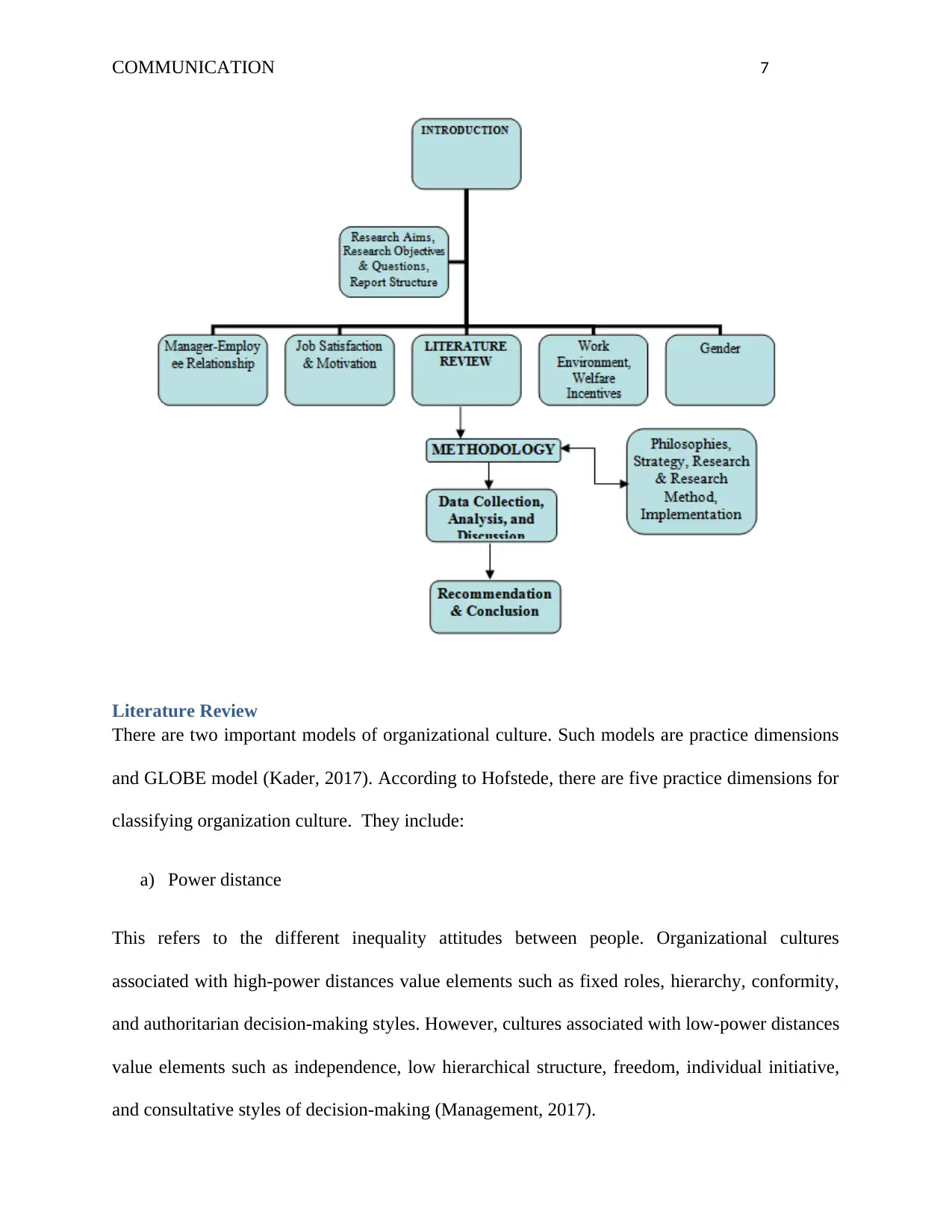
COMMUNICATION 7
Literature Review
There are two important models of organizational culture. Such models are practice dimensions
and GLOBE model (Kader, 2017). According to Hofstede, there are five practice dimensions for
classifying organization culture. They include:
a) Power distance
This refers to the different inequality attitudes between people. Organizational cultures
associated with high-power distances value elements such as fixed roles, hierarchy, conformity,
and authoritarian decision-making styles. However, cultures associated with low-power distances
value elements such as independence, low hierarchical structure, freedom, individual initiative,
and consultative styles of decision-making (Management, 2017).
Literature Review
There are two important models of organizational culture. Such models are practice dimensions
and GLOBE model (Kader, 2017). According to Hofstede, there are five practice dimensions for
classifying organization culture. They include:
a) Power distance
This refers to the different inequality attitudes between people. Organizational cultures
associated with high-power distances value elements such as fixed roles, hierarchy, conformity,
and authoritarian decision-making styles. However, cultures associated with low-power distances
value elements such as independence, low hierarchical structure, freedom, individual initiative,
and consultative styles of decision-making (Management, 2017).
Paraphrase This Document
Need a fresh take? Get an instant paraphrase of this document with our AI Paraphraser
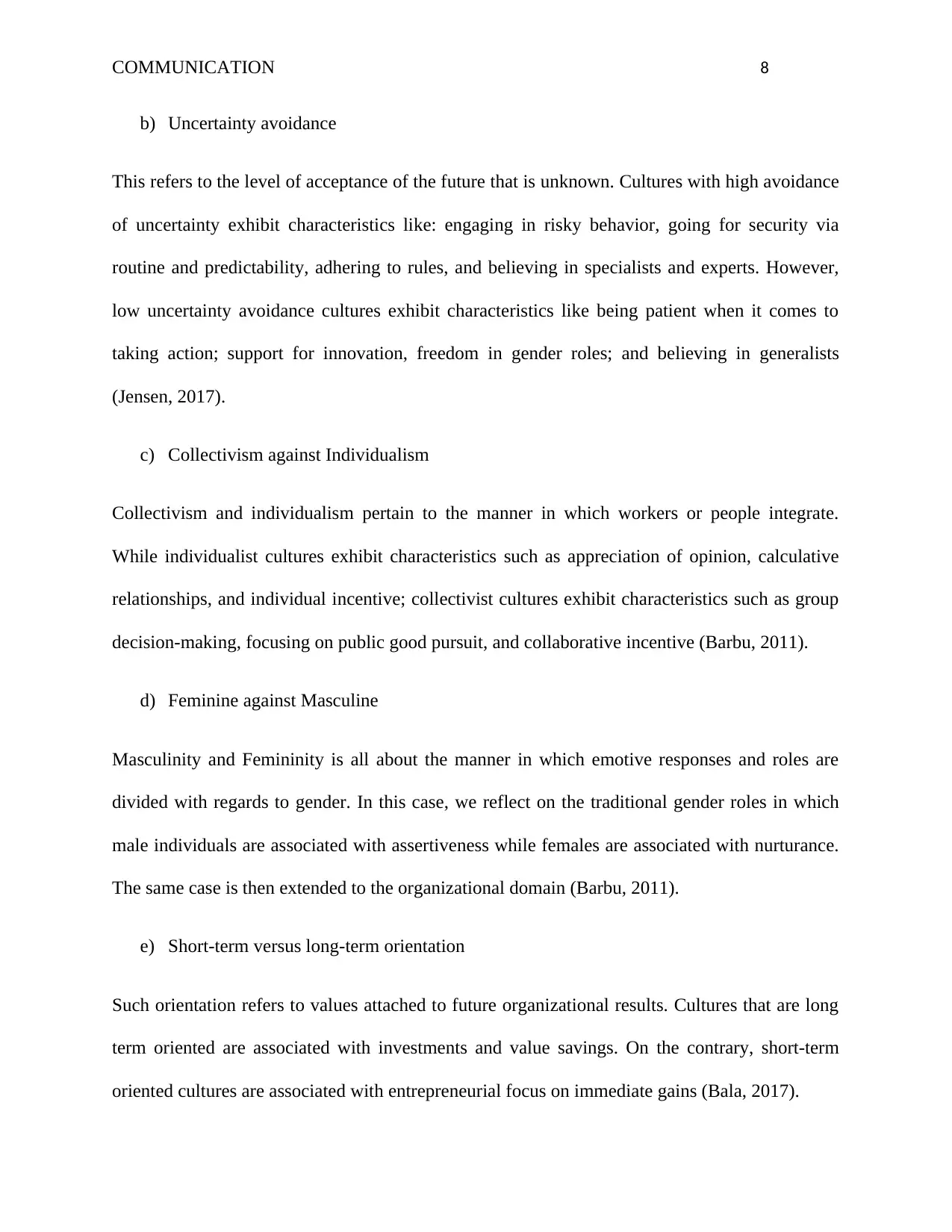
COMMUNICATION 8
b) Uncertainty avoidance
This refers to the level of acceptance of the future that is unknown. Cultures with high avoidance
of uncertainty exhibit characteristics like: engaging in risky behavior, going for security via
routine and predictability, adhering to rules, and believing in specialists and experts. However,
low uncertainty avoidance cultures exhibit characteristics like being patient when it comes to
taking action; support for innovation, freedom in gender roles; and believing in generalists
(Jensen, 2017).
c) Collectivism against Individualism
Collectivism and individualism pertain to the manner in which workers or people integrate.
While individualist cultures exhibit characteristics such as appreciation of opinion, calculative
relationships, and individual incentive; collectivist cultures exhibit characteristics such as group
decision-making, focusing on public good pursuit, and collaborative incentive (Barbu, 2011).
d) Feminine against Masculine
Masculinity and Femininity is all about the manner in which emotive responses and roles are
divided with regards to gender. In this case, we reflect on the traditional gender roles in which
male individuals are associated with assertiveness while females are associated with nurturance.
The same case is then extended to the organizational domain (Barbu, 2011).
e) Short-term versus long-term orientation
Such orientation refers to values attached to future organizational results. Cultures that are long
term oriented are associated with investments and value savings. On the contrary, short-term
oriented cultures are associated with entrepreneurial focus on immediate gains (Bala, 2017).
b) Uncertainty avoidance
This refers to the level of acceptance of the future that is unknown. Cultures with high avoidance
of uncertainty exhibit characteristics like: engaging in risky behavior, going for security via
routine and predictability, adhering to rules, and believing in specialists and experts. However,
low uncertainty avoidance cultures exhibit characteristics like being patient when it comes to
taking action; support for innovation, freedom in gender roles; and believing in generalists
(Jensen, 2017).
c) Collectivism against Individualism
Collectivism and individualism pertain to the manner in which workers or people integrate.
While individualist cultures exhibit characteristics such as appreciation of opinion, calculative
relationships, and individual incentive; collectivist cultures exhibit characteristics such as group
decision-making, focusing on public good pursuit, and collaborative incentive (Barbu, 2011).
d) Feminine against Masculine
Masculinity and Femininity is all about the manner in which emotive responses and roles are
divided with regards to gender. In this case, we reflect on the traditional gender roles in which
male individuals are associated with assertiveness while females are associated with nurturance.
The same case is then extended to the organizational domain (Barbu, 2011).
e) Short-term versus long-term orientation
Such orientation refers to values attached to future organizational results. Cultures that are long
term oriented are associated with investments and value savings. On the contrary, short-term
oriented cultures are associated with entrepreneurial focus on immediate gains (Bala, 2017).
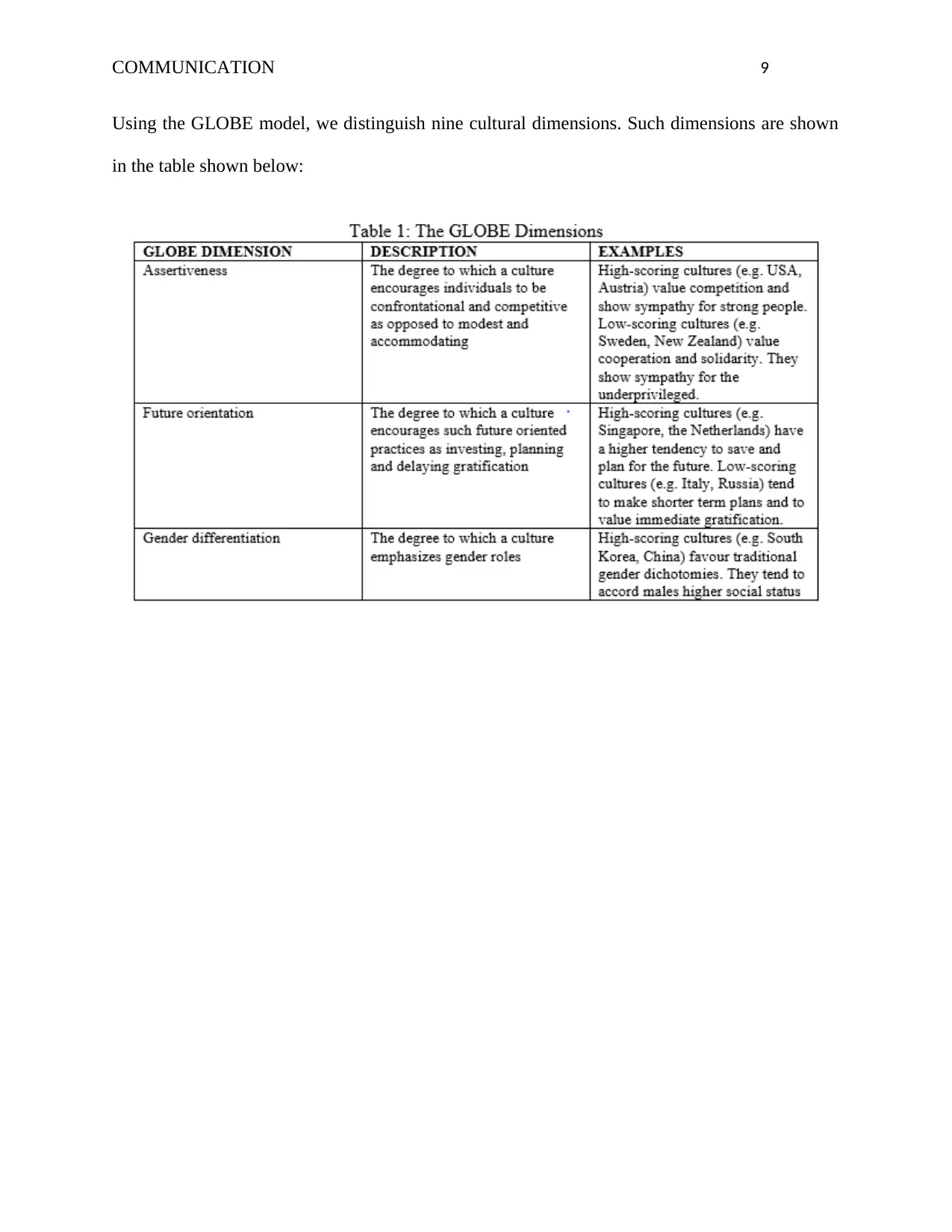
COMMUNICATION 9
Using the GLOBE model, we distinguish nine cultural dimensions. Such dimensions are shown
in the table shown below:
Using the GLOBE model, we distinguish nine cultural dimensions. Such dimensions are shown
in the table shown below:
⊘ This is a preview!⊘
Do you want full access?
Subscribe today to unlock all pages.

Trusted by 1+ million students worldwide
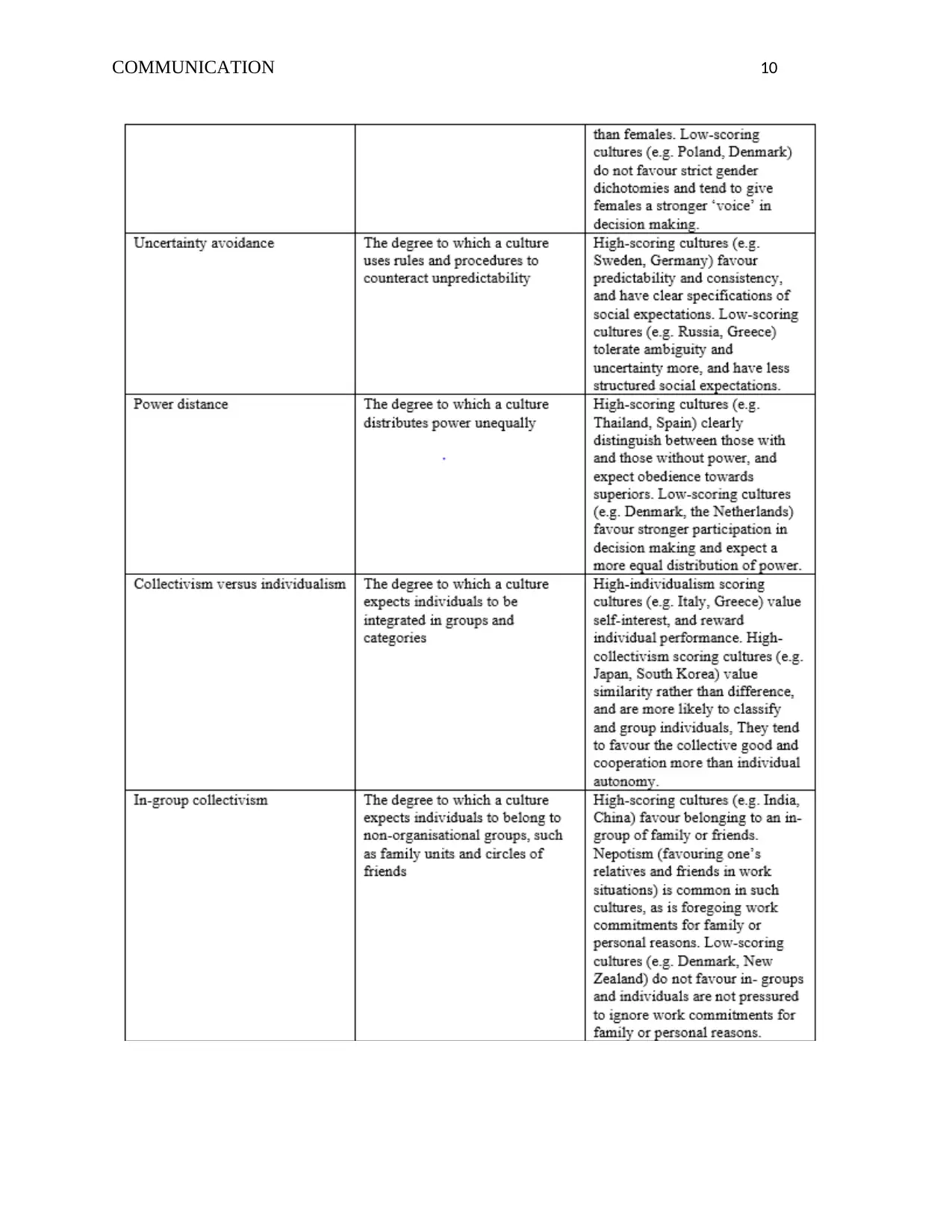
COMMUNICATION 10
Paraphrase This Document
Need a fresh take? Get an instant paraphrase of this document with our AI Paraphraser
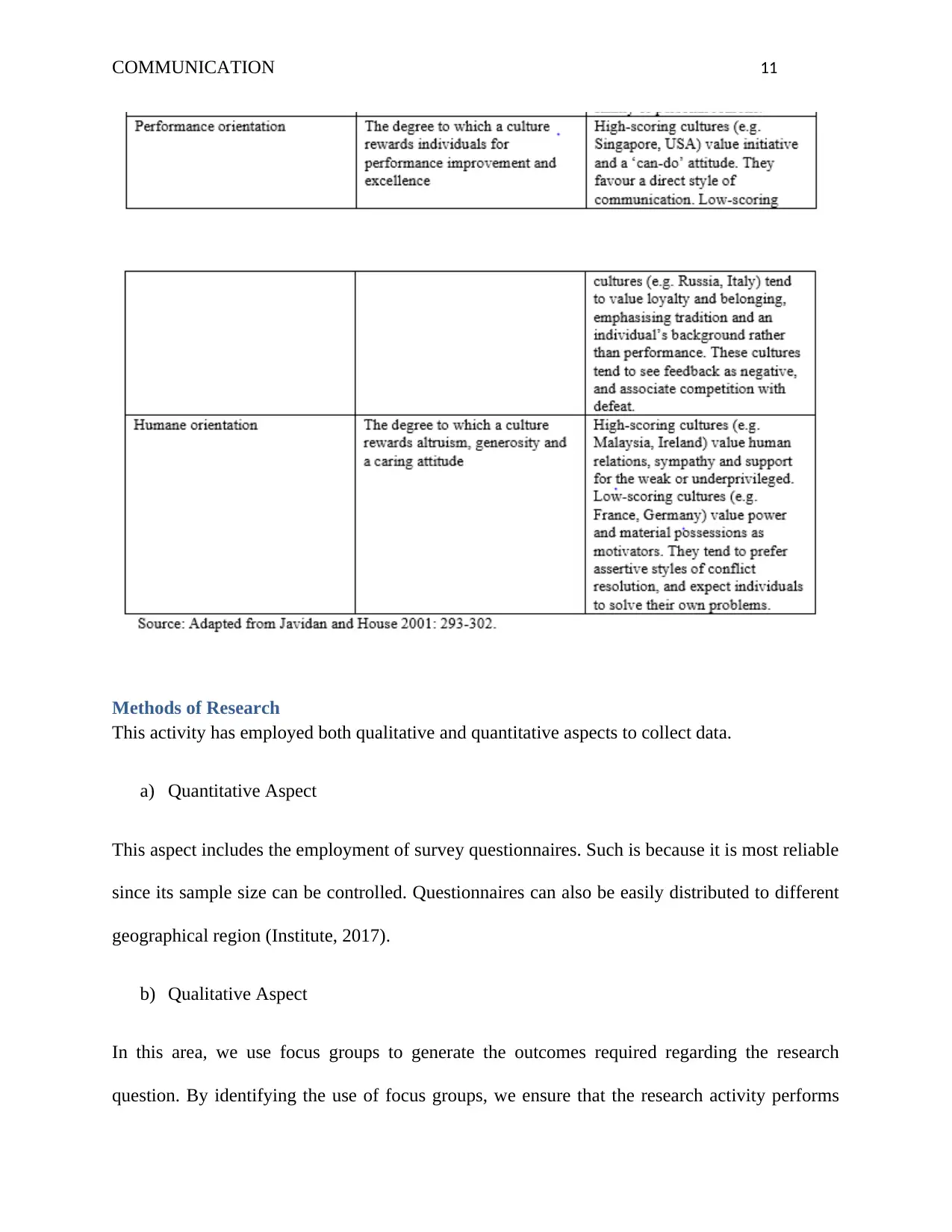
COMMUNICATION 11
Methods of Research
This activity has employed both qualitative and quantitative aspects to collect data.
a) Quantitative Aspect
This aspect includes the employment of survey questionnaires. Such is because it is most reliable
since its sample size can be controlled. Questionnaires can also be easily distributed to different
geographical region (Institute, 2017).
b) Qualitative Aspect
In this area, we use focus groups to generate the outcomes required regarding the research
question. By identifying the use of focus groups, we ensure that the research activity performs
Methods of Research
This activity has employed both qualitative and quantitative aspects to collect data.
a) Quantitative Aspect
This aspect includes the employment of survey questionnaires. Such is because it is most reliable
since its sample size can be controlled. Questionnaires can also be easily distributed to different
geographical region (Institute, 2017).
b) Qualitative Aspect
In this area, we use focus groups to generate the outcomes required regarding the research
question. By identifying the use of focus groups, we ensure that the research activity performs
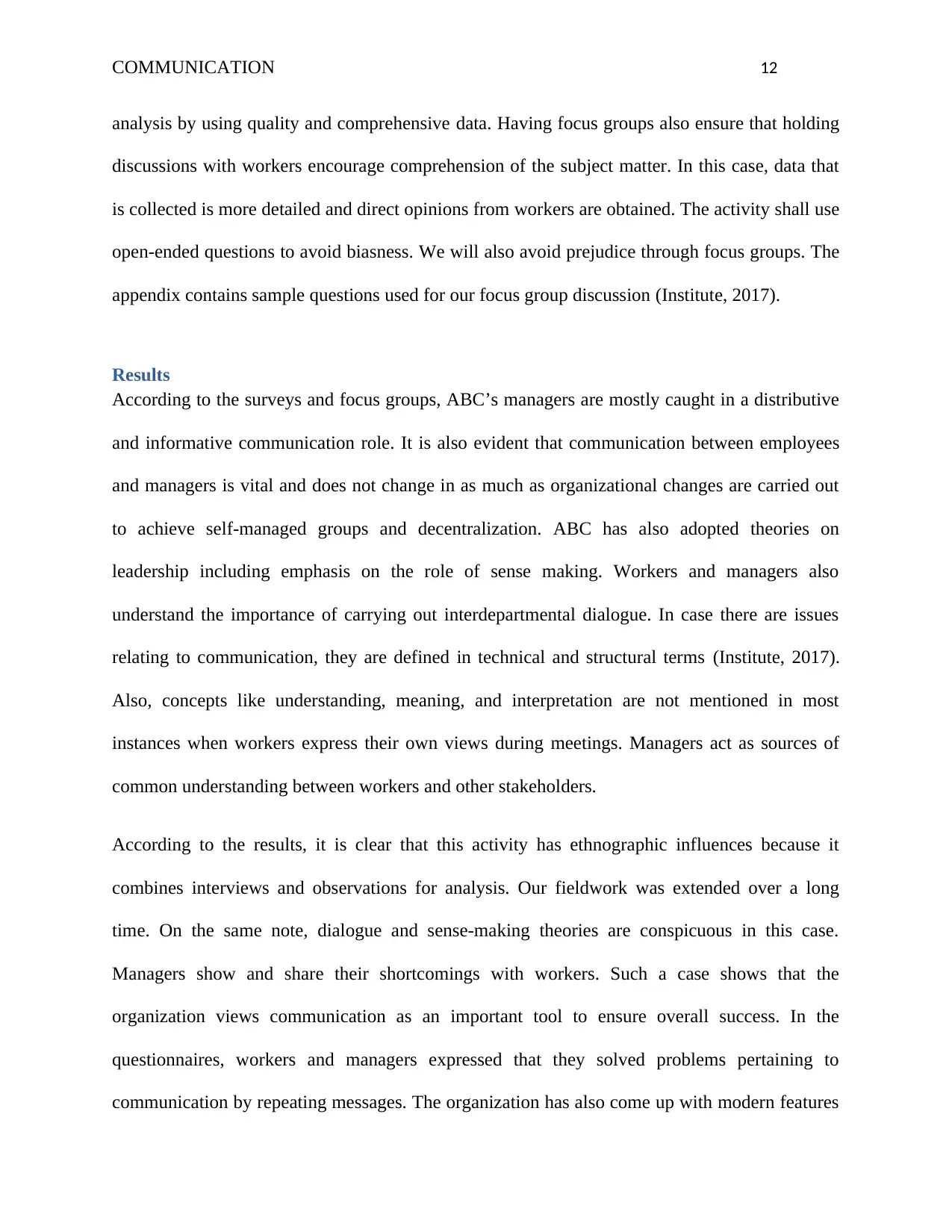
COMMUNICATION 12
analysis by using quality and comprehensive data. Having focus groups also ensure that holding
discussions with workers encourage comprehension of the subject matter. In this case, data that
is collected is more detailed and direct opinions from workers are obtained. The activity shall use
open-ended questions to avoid biasness. We will also avoid prejudice through focus groups. The
appendix contains sample questions used for our focus group discussion (Institute, 2017).
Results
According to the surveys and focus groups, ABC’s managers are mostly caught in a distributive
and informative communication role. It is also evident that communication between employees
and managers is vital and does not change in as much as organizational changes are carried out
to achieve self-managed groups and decentralization. ABC has also adopted theories on
leadership including emphasis on the role of sense making. Workers and managers also
understand the importance of carrying out interdepartmental dialogue. In case there are issues
relating to communication, they are defined in technical and structural terms (Institute, 2017).
Also, concepts like understanding, meaning, and interpretation are not mentioned in most
instances when workers express their own views during meetings. Managers act as sources of
common understanding between workers and other stakeholders.
According to the results, it is clear that this activity has ethnographic influences because it
combines interviews and observations for analysis. Our fieldwork was extended over a long
time. On the same note, dialogue and sense-making theories are conspicuous in this case.
Managers show and share their shortcomings with workers. Such a case shows that the
organization views communication as an important tool to ensure overall success. In the
questionnaires, workers and managers expressed that they solved problems pertaining to
communication by repeating messages. The organization has also come up with modern features
analysis by using quality and comprehensive data. Having focus groups also ensure that holding
discussions with workers encourage comprehension of the subject matter. In this case, data that
is collected is more detailed and direct opinions from workers are obtained. The activity shall use
open-ended questions to avoid biasness. We will also avoid prejudice through focus groups. The
appendix contains sample questions used for our focus group discussion (Institute, 2017).
Results
According to the surveys and focus groups, ABC’s managers are mostly caught in a distributive
and informative communication role. It is also evident that communication between employees
and managers is vital and does not change in as much as organizational changes are carried out
to achieve self-managed groups and decentralization. ABC has also adopted theories on
leadership including emphasis on the role of sense making. Workers and managers also
understand the importance of carrying out interdepartmental dialogue. In case there are issues
relating to communication, they are defined in technical and structural terms (Institute, 2017).
Also, concepts like understanding, meaning, and interpretation are not mentioned in most
instances when workers express their own views during meetings. Managers act as sources of
common understanding between workers and other stakeholders.
According to the results, it is clear that this activity has ethnographic influences because it
combines interviews and observations for analysis. Our fieldwork was extended over a long
time. On the same note, dialogue and sense-making theories are conspicuous in this case.
Managers show and share their shortcomings with workers. Such a case shows that the
organization views communication as an important tool to ensure overall success. In the
questionnaires, workers and managers expressed that they solved problems pertaining to
communication by repeating messages. The organization has also come up with modern features
⊘ This is a preview!⊘
Do you want full access?
Subscribe today to unlock all pages.

Trusted by 1+ million students worldwide
1 out of 22
Related Documents
Your All-in-One AI-Powered Toolkit for Academic Success.
+13062052269
info@desklib.com
Available 24*7 on WhatsApp / Email
![[object Object]](/_next/static/media/star-bottom.7253800d.svg)
Unlock your academic potential
Copyright © 2020–2025 A2Z Services. All Rights Reserved. Developed and managed by ZUCOL.




